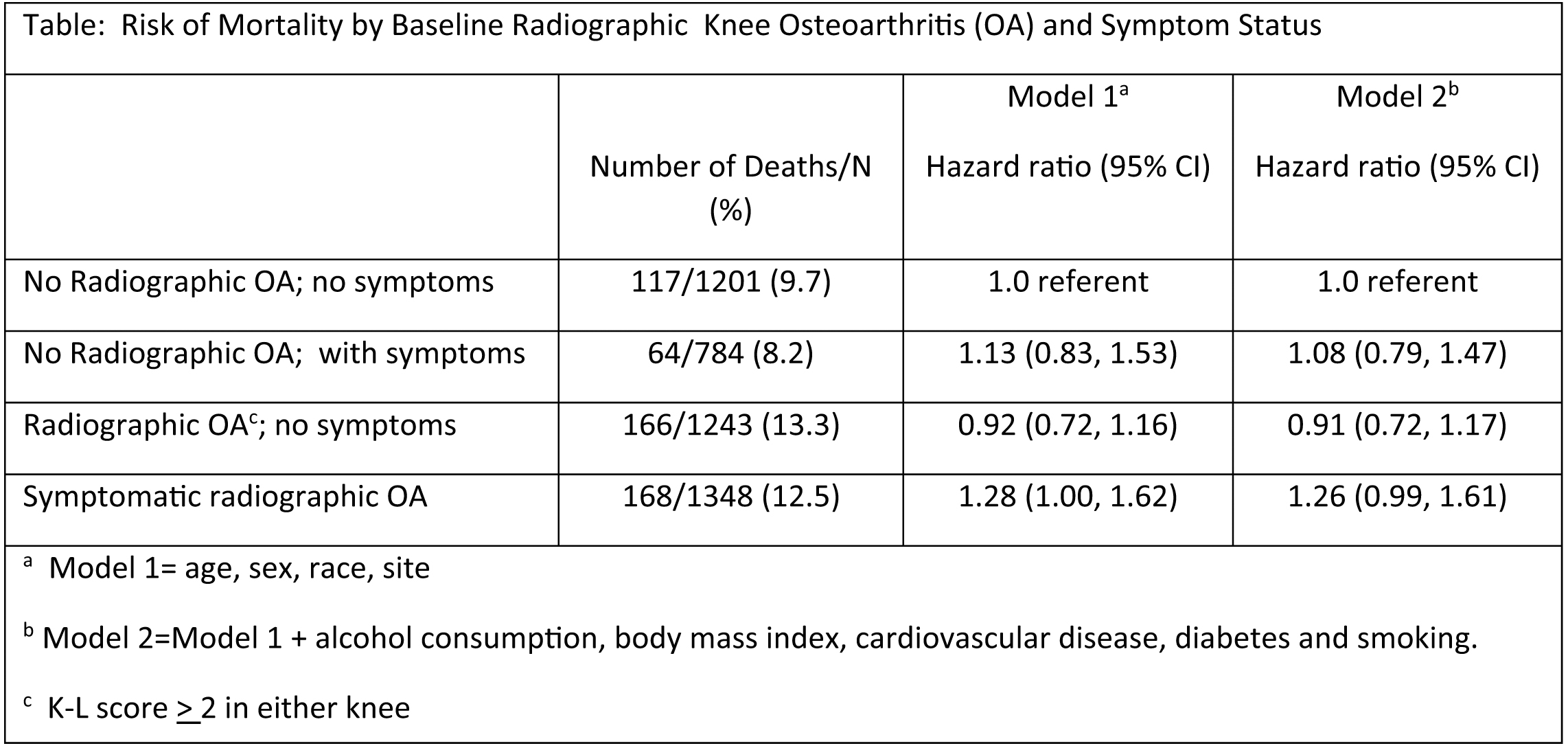Session Information
Date: Monday, November 8, 2021
Title: Epidemiology & Public Health Poster III: Other Rheumatic & Musculoskeletal Diseases (1022–1060)
Session Type: Poster Session C
Session Time: 8:30AM-10:30AM
Background/Purpose: A recent international individual participant data (IPD) meta-analysis (n=10,723) reported a 35-37% increased mortality risk among individuals with painful knees (no radiographic OA) and symptomatic radiographic knee OA (Leyland K et al 2021). We examined whether these results could be replicated in the Osteoarthritis (OAI) cohort (not included in the international IPD) using complete, long-term data on participant deaths from the OAI.
Methods: The OAI is a prospective cohort study investigating risk factors and biomarkers associated with the development and progression of knee OA. A total 4,796 adults age 45-79 years with or at high risk of developing knee OA were recruited at five US clinical sites. A National Death Index search was initiated to identify all deaths from 2004-2018. We used OAI baseline data on radiographic knee OA (K-L grade >=2), knee symptoms (pain on most days of a month in past year) and symptomatic OA (radiographic OA and symptoms in the same knee) to classify participants into four groups: symptomatic OA in one or both knees; no symptomatic OA but has radiographic OA in one or both knees; no radiographic OA but has symptoms in one or both knees; no radiographic OA or symptoms in either knee (referent group). Cox proportional hazards models were used to calculate hazard ratios (HR) for mortality, and their 95% confidence Intervals (CI), adjusted for covariates, in each group compared to the referent group. We excluded those who had a knee replacement at baseline (n=63) and missing data on covariates.
Results: The mean age of the cohort at baseline was 61 years; 80% were white; 58% were women. Over an average follow-up of 9.2 years, 515 (11.3%) died. Of those with no radiographic OA and no symptoms, 9.7% died; no radiographic OA with symptoms, 8.2% died; radiographic OA and no symptoms, 13.4% died and radiographic OA and symptoms, 12.5% died, p< 0.0005, See Table. In multivariable adjusted models there was a marginally significant 28% increase in mortality (p=0.065) in participants with symptomatic knee OA at baseline. The association with mortality was stronger in those with symptomatic knee OA with a K-L grade 3 or 4 HR= 1.32 (1.00, 1.73) compared with those symptomatic OA with K-L score of 2, HR=1.17(0.85, 1.63). We also examined the association between frequent knee symptoms in either knee, adjusting for K-L grade; those with frequent knee pain had an increased risk of death, HR= 1.19 (0.99, 1.43).
Conclusion: These results with complete long-term follow-up data from the OAI cohort are consistent with those from the individual level meta-analysis showing increased mortality among those with symptomatic knee OA.
To cite this abstract in AMA style:
Cauley J, Nevitt M, Sun K, Maeda J, Kwoh C, Sharma L, Jackson R, Rubin S, Hochberg M. Knee Osteoarthritis and Mortality: The Osteoarthritic Initiative [abstract]. Arthritis Rheumatol. 2021; 73 (suppl 9). https://acrabstracts.org/abstract/knee-osteoarthritis-and-mortality-the-osteoarthritic-initiative/. Accessed .« Back to ACR Convergence 2021
ACR Meeting Abstracts - https://acrabstracts.org/abstract/knee-osteoarthritis-and-mortality-the-osteoarthritic-initiative/

